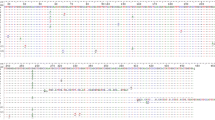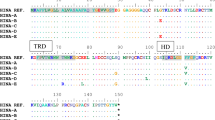Abstract
Key message
Genetic (different forms of puroindoline-b) and environment (through variations in vitreousness), have important effects on wheat grain mechanical properties. The two methods of hardness measurements (NIRS, SKCS) do not give the same information.
Abstract
Bread wheat near-isogenic lines differing in hardness, due to distinct puroindoline-b alleles (the wild type, Pinb-D1a, or the mutated forms, Pinb-D1b or Pinb-D1d), were grown for three years in seven sites and under two nitrogen fertilization levels, to study genetic and environmental effects on grain mechanical properties. Two methods, Near-Infrared Reflectance Spectroscopy (NIRS) and Single Kernel Characterization System (SKCS), currently used for grain hardness characterization, were carried out. Grain vitreousness, which is known to affect the grain mechanical behavior but is generally not studied, was also measured, as well as three other characters (Thousand Grain Weight, Test Weight and protein content). The relationships between the different characters were studied. Results revealed a clear effect of the different Pinb-D1 alleles on NIRS hardness, and a marked impact of the environmental conditions on vitreousness. SKCS hardness was influenced by both Pinb-D1 alleles and environmental conditions. The relationship between SKCS and NIRS hardness was strong when considering together soft and hard genotypes, but moderate within a class of genetical hardness. Vitreousness had only a weak effect on NIRS hardness, whereas vitreousness and SKCS values were strongly correlated, with two distinct regressions for soft and hard genotypes. Vitreousness was positively related to protein content, especially in the case of hard genotypes, which were able to reach high vitreousness values never observed for soft genotypes.




Similar content being viewed by others
References
AACC (2000) American Association of Cereal Chemists Approved Methods, 10th edn. The Association, St Paul
Akbari M, Wenzl P, Caig V, Carling J, Xia L, Yang SY, Uszynski G, Mohler V, Lehmensiek A, Kuchel H, Hayden MJ, Howes N, Sharp P, Vaughan P, Rathmell B, Huttner E, Kilian A (2006) Diversity arrays technology (DArT) for high-throughput profiling of the hexaploid wheat genome. Theor Appl Genet 113:1409–1420
Beecher B, Bettge A, Smidansky E, Giroux MJ (2002) Expression of wild type pinB sequence in transgenic wheat complements a hard genotype. Theor Appl Genet 105:870–877
Breseghello F, Finney PL, Gaines C, Andrews L, Tanaka J, Penner G, Sorrells ME (2005) Genetic loci related to kernel quality differences between a soft and a hard wheat cultivar. Crop Sci 45:1685–1695
Campbell KG, Bergman CJ, Gualberto DG, Anderson JA, Giroux MJ, Hareland G, Fulcher RG, Sorrells ME, Finney PL (1999) Quantitative trait loci associated with kernel traits in a soft x hard wheat cross. Crop Sci 39:1184–1195
Chantret N, Salse J, Sabot F, Rahman S, Bellec A, Laubin B, Dubois I, Dossat C, Sourdille P, Joudrier P, Gautier M-F, Cattolico L, Beckert M, Aubourg S, Weissenbach J, Caboche M, Bernard M, Leroy P, Chalhoub B (2005) Molecular basis of evolutionary events that shaped the hardness locus in diploid and polyploid wheat species (Triticum and Aegilops). Plant Cell 17(4):1033–1045
Day L, Bhandari DG, Greenwell P, Leonard SA, Schofield JD (2006) Characterization of wheat puroindoline proteins. FEBS J 273:5358–5373
Dexter JE, Marchylo BA, Mac Gregor AW, Tkachuk R (1989) The structure and protein composition of vitreous, piebald and starchy durum wheat kernels. J Cereal Sci 10:19–32
Dobraszczyk BJ, Whitworth MB, Vinczent JFV, Khan AA (2002) Single kernel wheat hardness and fracture properties in relation to density and the modeling of fracture in wheat endosperm. J Cereal Sci 35:245–263
Feiz L, Wanjugi HW, Melnyk CW, Altosaar I, Martin JM, Giroux MJ (2009) Puroindolines co-localize to the starch granule surface and increase seed bound polar lipid content. J Cereal Sci 50:91–98
Gaines CS, Finney PF, Fleege LM, Andrews C (1996) Predicting a hardness measurement using the single-kernel characterization system. Cereal Chem 73(2):278–283
Gazza L, Taddei F, Corbellini M, Cacciatori P, Pogna NE (2008) Genetic and environmental factors affecting grain texture in common wheat. J Cereal Sci 47(1):52–58
Giroux MJ, Morris CF (1998) Wheat grain hardness results from highly conserved mutation in the friabilin components puroindoline a and b. Proc Natl Sci USA 95:6262–6266
Greffeuille V, Abecassis J, Rousset M, Oury F-X, Faye A, Bar L’Helgouac’h C, Lullien-Pellerin V (2006) Grain characterization and milling behavior of near-isogenic lines differing by hardness. Theor Appl Genet 114(1):1–12
Greffeuille V, Abecassis J, Barouh N, Villeneuve P, Mabille F, Bar L’Helgouac’h C, Lullien-Pellerin V (2007) Analysis of the milling reduction of bread wheat farina: physical and biochemical characterization. J Cereal Sci 45:97–105
Haddad Y, Mabille F, Mermet A, Abecassis J, Benet J-C (1999) Rheological properties of wheat endosperm with a view on grinding behavior. Powder Technol 105:89–94
Haddad Y, Benet JC, Delenne J-Y, Mermet A, Abecassis J (2001) Rheological behavior of wheat endosperm-proposal for classification based on rheological characteristics of endosperm test samples. J Cereal Sci 34:105–113
Hazen SP, Ward RW (1997) Variation in soft winter wheat characteristics measured by the single kernel characterization system. Crop Sci 37:1079–1086
Huang X-Q, Röder MS (2005) Development of SNP assays for genotyping the puroindoline b gene for grain ghradness in wheat using pyrosequencing. J Agric Food Chem 53:2070–2075
Lasme P, Oury F-X, Michelet C, Abecassis J, Mabille F, Bar L’Helgouac’h C, Lullien-Pellerin V (2012) A study of puroindoline b gene involvement in the milling behavior of hard-type common wheats. Cereal Chem 89(1):44–51
Lillemo M, Morris CF (2000) A leucine to proline mutation in puroindoline b is frequently present in hard wheats from Northern Europe. Theor Appl Genet 100:1100–1107
Martin CR, Rousser R, Brabec DL (1993) Development of single kernel wheat characterization system. Trans ASAE 36(5):1399–1404
Morris CF, Beecher BS (2012) The distal portion of the short arm of wheat (Triticum aestivum L) chromosome 5D controls endosperm vitreosity and grain hardness. Theor Appl Genet 125:247–254
Morris CF, Bhave M (2008) Reconciliation of D-genome puroindoline allele designations with current DNA sequence data. J Cereal Sci 48:277–287
Morris CF, Massa AN (2003) Puroindoline genotype of the US National institute of standards and technology reference material 8441, wheat hardness. Cereal Chem 80(6):674–678
Orucevic S, Ugarcic-Hardi Z, Begic-Akagic A, Spaho N (2007) Wheat hardness index in relation to the other wheat quality parameters. In: Proceedings of the 4th international congress on flour-bread 7p
Parish JA, Halse NJ (1968) Effects of light, temperature, and rate of desiccation on translucency in wheat grain. Austr J Agric Res 19:365–372
Pauly A, Pareyt B, Fierens H, Delcour JA (2013) Wheat (Triticum aestivum L. and T. turgidum L.ssp. durum) kernel hardness: I. Current view on the role of puroindolines and polar lipids. Compr Rev Food Sci F 12:413–426
Pearson T, Wilson J, Gwirtz J, Maghirang E, Dowell F, McCluskey P, Bean S (2007) Relationships between single wheat kernel particle-size distribution and Perten SKCS 4100 hardness index. Cereal Chem 84(6):567–575
Pomeranz Y, Williams PC (1990) Wheat hardness: its genetics, structural, and biochemical background, measurement, and significance. In: Pomeranz Y (ed) Advances in Cereal Science and Technology, vol10. AACC, St Paul, pp 471–548
R Development Core Team (2009) R: a language and environment for statistical computing. R Foundation for Statistical Computing, Vienna, Austria ISBN 3-090051-07-0. URL http://www.R-projectorg
Samson M-F, Mabille F, Chéret R, Abecassis J, Morel M-H (2005) Mechanical and physicochemical characterization of vitreous and mealy durum wheat endosperm. Cereal Chem 82:81–87
Saurer W (1978) Use of infra-red reflectance measurement for determination of protein and water content and grain hardness in wheat. Getreide Mehl und Brot 32:272–276
Sharma GC, Paul AD, Bietz JA (1983) Nitrogen fertilization effects and anatomical, protein, and amino acid characteristics of yellow berry in triticale. Crop Sci 23:699–703
Sissons MJ, Osborne BG, Hare RA, Sissons SA, Jackson R (1999) Application of the single-kernel characterization system to durum wheat testing and quality prediction. Cereal Chem 77(1):4–10
Sourdille P, Perretant M-R, Charmet G, Leroy P, Gautier M-F, Joudrier P, Nelson JC, Sorrells ME, Bernard M (1996) Linkage between RFLP markers and genes affecting kernel hardness in wheat. Theor Appl Genet 93:580–586
Tenenhaus M (1998) La régression PLS: théorie et pratique. Editions Technip, Paris
Tenenhaus M, Gauchi J-P, Ménardo C (1995) Régression PLS et applications. Revue de Statistique Appliquée XLIII 1:7–63
Tomassone R, Lesquoy E, Millier C (1983) La régression: nouveaux regards sur une ancienne méthode statistique. INRA et Masson, Paris, p 184
Topin V, Radjaï F, Delenne J-Y, Mabille F (2009) Mechanical modelling of wheat hardness and fragmentation. Powder Technol 190:215–220
Turnbull KM, Rahman S (2002) Endosperm texture in wheat. J Cereal Sci 36:327–337
Wanjugi HW, Hogg AC, Martin JM, Giroux MJ (2007) The role of puroindoline a and b individually and in combination on grain hardness and starch association. Crop Sci 47:67–76
Weightman RM, Millar S, Alava J, Foulkes MJ, Fish L, Snape JW (2008) Effects of drought and the presence of the 1BL/RS translocation on grain vitreosity, hardness and protein content in winter wheat. J Cereal Sci 47:457–468
Williams PC, Sobering DC (1986) Attempts at standardization of hardness testing of wheat 1 The grinding sieving (particle size index) method. Cereal Foods World 31:359–364
Acknowledgments
We are grateful to all the INRA and UFS agents implicated in the field trials or the measurements of grain parameters, and to S. Alquié and N. Beaubras (INRA non permanent staff) for their measurement of grain vitreousness.
This work was granted by FSOV (Fonds de Soutien à l’Obtention Végétale, 2007-2010).
Conflict of interest
The authors declare that they have no conflict of interest.
Ethical standards
The authors declare that the experiments described in this manuscript comply with the current laws in France.
Author information
Authors and Affiliations
Corresponding author
Additional information
Communicated by I. D. Godwin.
Rights and permissions
About this article
Cite this article
Oury, FX., Lasme, P., Michelet, C. et al. Relationships between wheat grain physical characteristics studied through near-isogenic lines with distinct puroindoline-b allele. Theor Appl Genet 128, 913–929 (2015). https://doi.org/10.1007/s00122-015-2479-z
Received:
Accepted:
Published:
Issue Date:
DOI: https://doi.org/10.1007/s00122-015-2479-z




